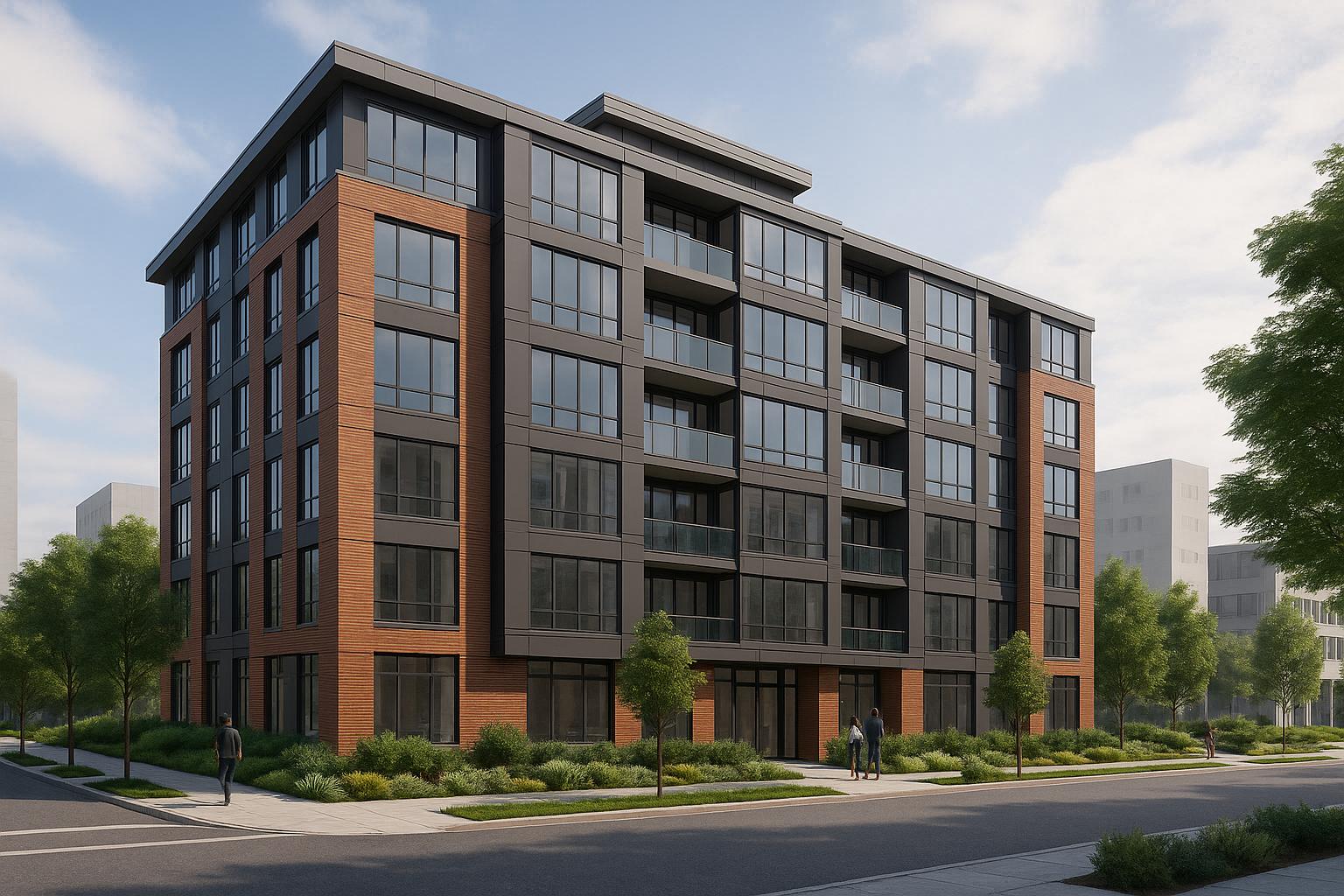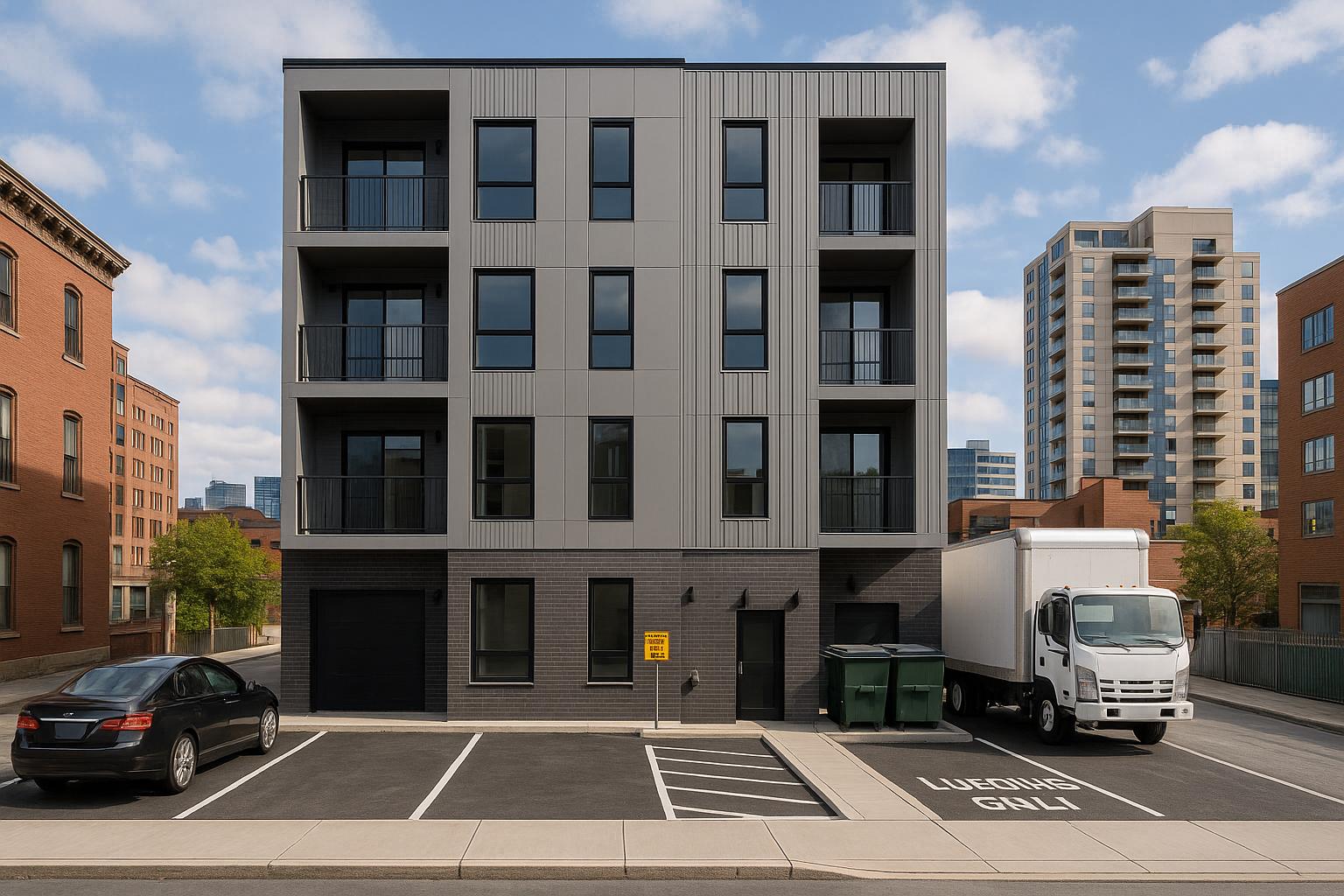New home warranties in Nova Scotia protect property owners from construction defects in newly built homes. They cover issues like structural defects, faulty materials, and poor workmanship. While not mandatory in Nova Scotia, many builders offer coverage through the Atlantic Home Warranty Program, which provides up to $70,000 per home with no deductible.
Key coverage details include:
- Materials & Workmanship: Plumbing, electrical, HVAC, and finishes (1–2 years).
- Water Damage: Roof leaks, window seepage, and moisture issues (2 years).
- Structural Defects: Foundations, load-bearing walls, and roofs (up to 10 years).
- Shared Spaces in Multi-Unit Buildings: Hallways, roofs, and exterior walls, starting from condominium registration.
Exclusions include normal wear and tear, weather damage, neglect, and tenant-related issues for rental properties. Property owners must maintain their homes and follow warranty terms to ensure coverage.
For multi-unit rental properties, managing warranty claims can be complex, especially for shared areas. Working with an integrated design-build team simplifies the process, ensuring faster resolutions and clear accountability.
Understand New Home Warranties
What New Home Warranties Cover
In Nova Scotia, new home warranties offer protection against various construction defects that could lead to hefty repair bills if left unresolved. Knowing what’s covered can help you stay ahead of potential issues and protect your investment, especially in multi-unit rental properties.
Materials and Workmanship Defects
This type of coverage addresses flaws in systems like plumbing, electrical, heating, ventilation, and interior finishes. For example, it might cover leaking pipes, faulty wiring, or a malfunctioning HVAC system. In multi-unit properties, even a single issue in a shared system can disrupt tenants and impact rental income during repairs. While warranty programs generally include these protections, the specific coverage limits and details can differ.
One way to reduce the likelihood of these problems is by working with an integrated design-build team. When the same group manages design, material selection, and construction, there’s a clear line of accountability for quality control. This approach helps lower the risks tied to fragmented oversight. Now, let’s shift focus to structural concerns, which come with different coverage terms.
Major Structural Problems
Structural defects, which are typically covered for up to 10 years [1], involve critical load-bearing components like foundations, walls, and roof systems. Repairs for these issues can average around $35,000 [2]. A structural defect includes any flaw in materials, labour, or design that compromises the building’s integrity. Commonly covered elements include foundations, load-bearing walls, roof framing, footings, piles, grade beams, beams, teleposts, and floor systems.
For multi-unit properties, the scale of these problems can create even greater challenges. If a structural defect renders a property uninhabitable, warranty programs - such as the Atlantic Home Warranty Program - may offer a Living Out Allowance to help offset temporary living expenses [1].
Building Code Violations and Water Damage
New home warranties also provide protection when construction doesn’t meet local building codes, ensuring that properties meet required safety and construction standards. Water damage coverage deals with issues like roof leaks, water infiltration, and moisture ingress - problems that can escalate quickly in rental properties.
That said, warranties usually exclude damage caused by normal shrinkage or settling, as well as issues resulting from homeowner neglect, poor maintenance, or unauthorized modifications.
Multi-Unit Building Common Areas
For multi-unit buildings, shared spaces often require extra attention. Warranty coverage typically extends to common areas such as hallways, stairwells, mechanical rooms, roofs, and exterior walls once the condominium corporation is officially registered. While individual units are covered from the possession date, common areas are generally protected starting from the condominium registration date.
This distinction is crucial for owners of fourplexes or larger rental properties. Defects in shared systems or structural elements can impact multiple tenants, so having warranty coverage for these areas simplifies the claims process across both individual units and shared spaces.
How Long Warranty Coverage Lasts
Understanding warranty timelines is essential for planning repairs and submitting claims within the allowed period. In Nova Scotia, the duration of warranty coverage depends on the type of defect and the specific warranty program in place.
Standard Warranty Time Periods
The length of warranty coverage varies based on the nature of the defect:
- Materials and Workmanship: Issues such as plumbing, electrical systems, HVAC, and interior finishes are typically covered for 1–2 years.
- Water Penetration: Problems like roof leaks, window seepage, and moisture infiltration through exterior walls generally have a coverage period of around two years.
- Structural Defects: These include issues with foundations, load-bearing walls, or roof framing, which are often covered for up to 10 years due to their potential severity and the time it may take for such problems to become evident.
Coverage Amount Limits in Nova Scotia
Warranty programs usually establish maximum payout limits for repairs, which can differ by the type of coverage and provider. Coverage for materials and workmanship often has lower limits since these repairs are typically less costly. In contrast, structural defect coverage tends to have higher limits because of the potentially significant expenses involved.
Always review your warranty documents to understand the financial protection available for each type of defect.
Coverage Duration Summary Table
| Coverage Type | Duration | What's Included |
|---|---|---|
| Materials & Workmanship | 1–2 years | Plumbing, electrical, HVAC, interior finishes |
| Water Penetration | 2 years | Roof leaks, window seepage, exterior wall moisture |
| Structural Defects | Up to 10 years | Foundation, load-bearing walls, roof framing |
It’s important to note that the start date for warranty coverage can vary. For individual units, coverage typically begins on the possession date. For common areas in condominium buildings, it usually starts from the registration date of the condominium corporation.
sbb-itb-16b8a48
What's Not Covered by New Home Warranties
New home warranties are designed to protect key construction elements, but they come with limitations. Knowing what’s excluded can help you avoid unexpected claim denials and ensure you don’t accidentally void your warranty.
Standard Warranty Exclusions
While warranties cover many structural and functional aspects of your home, there are specific exclusions that homeowners should be aware of:
- Normal wear and tear: Everyday issues like faded paint, worn-out carpeting, minor cracks from settling, or squeaky floors are not covered. These are considered part of the natural aging process of a home.
- Weather-related damage: Issues caused by storms, flooding, or freeze-thaw cycles, such as roof or siding damage from a winter storm, fall outside the scope of a warranty. These situations are typically handled through homeowner’s insurance.
- Owner neglect or improper maintenance: Skipping routine upkeep, like cleaning gutters or replacing HVAC filters, can lead to problems that won’t be covered. Neglecting these responsibilities may also void warranty protection for affected areas.
- Appliance defects: Appliances like refrigerators, dishwashers, and washing machines are usually covered by their own manufacturer warranties, not the home warranty.
- Landscaping and exterior features: Driveways, walkways, fences, and planted areas are generally excluded. These elements require separate maintenance and are subject to unique environmental stresses.
- Post-construction modifications: Changes made after construction, such as improperly installing a new electrical outlet, can void warranty coverage for the affected area - even if the original installation had defects.
Multi-Unit Property Coverage Limits
If you own a multi-unit property, there are additional restrictions to keep in mind:
- Tenant-caused damage: Any damage resulting from tenant misuse or negligence isn’t covered under the warranty.
- Excessive wear from rental use: High tenant turnover or insufficient maintenance between tenancies can lead to accelerated wear, which may void warranty coverage.
- Common area maintenance: Shared spaces like hallways, laundry rooms, or mechanical rooms require proper upkeep. Neglect here can compromise warranty protection for these areas.
- Tenant modifications: Unapproved changes made by tenants, such as installing fixtures or altering electrical systems, can void coverage for the impacted areas.
To preserve warranty protection, property owners must stay proactive about maintenance and ensure tenants follow proper guidelines.
Reading Your Warranty Agreement
Understanding your warranty agreement is crucial. Pay close attention to these key areas:
- Exclusion clauses: These list items not covered by the warranty, often in technical language that requires careful review.
- Maintenance requirements: These outline the upkeep needed to maintain warranty validity.
- Claim procedures: Warranties often have strict deadlines for filing claims, and missing these can result in denial.
- Coverage limits: Be aware that the warranty may not cover the full cost of repairs.
The agreement will also clarify whether certain issues require full replacements or if repairs that restore functionality (but not aesthetics) are sufficient. If anything in the warranty is unclear, ask your builder for clarification before signing - once construction begins, the terms become legally binding.
New Home Warranties for Multi-Unit Rental Properties
When it comes to multi-unit buildings, warranties work a little differently compared to single-family homes. Knowing what’s covered is key to safeguarding your investment and setting clear expectations for warranty coverage.
Individual Units vs. Shared Spaces
Multi-unit properties are covered on two levels: individual units and common areas. For individual rental units, the warranty typically includes protection against defects in materials and workmanship, major structural issues, and problems with the building envelope that directly affect the unit. However, property owners must keep up with regular maintenance to ensure the warranty remains valid.
For shared spaces - like hallways, mechanical rooms, and the building’s exterior - warranty coverage also applies. Since issues in these areas can affect multiple units, consistent upkeep is crucial to maintaining the warranty for the entire building. This dual focus on unit-specific and shared-space coverage highlights the importance of detailed planning during the construction phase.
The next step is ensuring your project meets the necessary requirements to secure proper warranty coverage.
Multi-Unit Project Requirements
In Nova Scotia, warranty coverage for condominiums isn’t legally required. Builders may choose to offer it voluntarily or through third-party providers [3].
For property owners looking for condominium-style warranty protection, compliance with the Condominium Act and Regulations is essential. This includes proving that all residential units have valid occupancy permits [4][5], along with meeting other regulatory standards that lay the groundwork for warranty eligibility.
Since warranties for multi-unit buildings are not mandatory, property owners should take an active role in securing coverage during the planning and construction stages. This often involves making specific arrangements with builders or third-party warranty providers to ensure the property is fully protected.
Key Points for Property Owners
If you're a property owner in Nova Scotia, understanding new home warranty coverage means knowing what’s protected, how long the coverage lasts, and what maintenance responsibilities you hold. These warranties generally cover issues related to materials, workmanship, the building envelope, and major structural components. To avoid headaches, review your warranty details carefully and stay on top of regular maintenance to address problems quickly.
For owners of multi-unit properties, things can get a bit more complex. Standard warranties don’t always fully cover all aspects of rental buildings, particularly shared areas like hallways or lobbies. If you’re constructing a fourplex or a larger rental property, it’s smart to plan ahead. Managing both individual units and shared systems can make warranty claims trickier, especially when problems affect multiple tenants.
Fragmented project teams - where architects, engineers, contractors, and subcontractors all work independently - can add another layer of difficulty. For example, a plumbing issue might spark debates about whether the responsibility lies with the general contractor, the plumber, or someone else entirely. This leaves property owners stuck in the middle, trying to resolve disputes.
An integrated design-build approach simplifies this process by consolidating everything - design, engineering, and construction - under one team. With a single point of contact, warranty issues are easier to manage, cutting down on confusion and speeding up resolutions.
For rental property owners, resolving warranty claims quickly is essential to protect rental income and keep tenants happy. A streamlined, integrated construction approach often leads to faster repairs, fewer disputes, and a smoother overall process compared to juggling multiple uncoordinated contractors.
FAQs
How can homeowners in Nova Scotia ensure their new home warranty remains valid?
To ensure your new home warranty remains valid in Nova Scotia, there are a few essential steps to keep in mind. Start by thoroughly reading your warranty certificate to understand what it covers and the deadlines for filing claims. Make sure to document any problems that come up - this includes taking photos, noting dates, and saving all correspondence with your builder or warranty provider. Staying on top of regular home maintenance is equally important, as failing to do so could lead to parts of your warranty being voided. If anything seems unclear, don’t hesitate to contact your builder or warranty provider for guidance.
What steps can property owners take to handle warranty claims for shared spaces in multi-unit buildings effectively?
To handle warranty claims for shared spaces in multi-unit buildings effectively, property owners should start by carefully reviewing the warranty documents. This will clarify what's covered and the timelines for making a claim. In Nova Scotia, most new home warranties include coverage for shared areas like hallways, lobbies, and mechanical systems, though the specifics can vary.
When an issue arises, make sure to document everything thoroughly. Take clear photos, write detailed descriptions, and note the dates of any incidents. It's crucial to notify the builder or warranty provider in writing as soon as possible since delays might jeopardize your claim. For shared spaces, it's a good idea to coordinate with other unit owners or the property management team. A unified approach ensures smoother communication and makes it easier to address all the affected areas.
By staying organized and addressing issues promptly, property owners can navigate the warranty process more effectively and keep their shared spaces in good condition.
How does warranty coverage differ between individual units and shared common areas in multi-unit properties under Nova Scotia's new home warranty programs?
Under Nova Scotia's new home warranty programs, individual units and shared common areas are treated differently to account for their distinct characteristics. For individual units, the warranty typically covers things like structural flaws, materials, and workmanship within the unit itself - think walls, flooring, and plumbing systems. On the other hand, common areas - such as lobbies, hallways, or shared mechanical systems - are generally covered for structural and functional elements that affect all residents.
Coverage periods can differ depending on the nature of the issue and whether it involves an individual unit or a common area. For instance, structural defects may be covered for a longer time compared to cosmetic concerns. It's essential for property owners and condo boards to carefully review their warranty documents to fully understand the specific terms and timelines for both private units and shared spaces.



